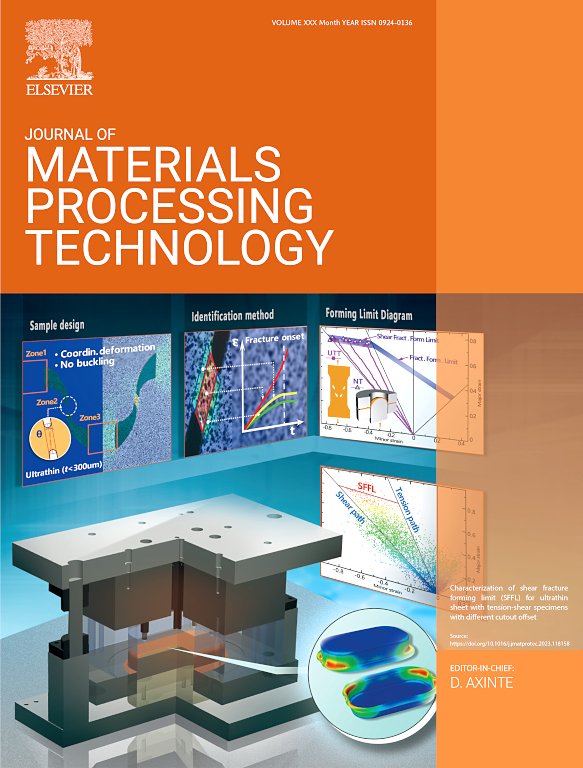Understanding the process limits of folding-shearing
IF 6.7
2区 材料科学
Q1 ENGINEERING, INDUSTRIAL
Journal of Materials Processing Technology
Pub Date : 2024-11-09
DOI:10.1016/j.jmatprotec.2024.118660
引用次数: 0
Abstract
Globally, 44 % of sheet metal used in the production of passenger vehicles is scrapped. To reduce this scrap, folding-shearing has been proposed previously. In this process, a blank is first folded to collect excess material in a region of incompatibility. Folded sheet is then sheared in-plane to achieve the target geometry. In a preliminary study, folding-shearing was used to create a U-channel part in a compression testing machine and a process operating window was defined by considering failure limits of springback, thinning and thickening. For the first time, this study develops analytical models, validated with numerical models and physical trials to define process limits and generate an understanding of the underlying mechanics of the process limits. These analytical models can be used as a basis to develop a process operating window instantly and are shown to be within 25 % of the process limits found using numerical models and physical trials. Results show that springback, thinning and thickening limits are strongly influenced by the part radius, height, fold geometry, and material properties.
了解折叠剪切的工艺限制
在全球范围内,乘用车生产过程中使用的金属板有 44% 报废。为了减少这些废料,以前曾提出过折叠-剪切工艺。在这一工艺中,首先对坯料进行折叠,以收集不相容区域的多余材料。然后对折叠板材进行平面剪切,以达到目标几何形状。在一项初步研究中,折叠-剪切工艺被用于在压缩试验机中制造 U 型槽零件,并通过考虑回弹、变薄和变厚的失效极限来定义工艺操作窗口。这项研究首次建立了分析模型,并通过数值模型和物理试验进行验证,以确定工艺极限,并了解工艺极限的基本力学原理。这些分析模型可作为即时开发工艺操作窗口的基础,并显示在使用数值模型和物理试验发现的工艺限制的 25% 范围内。结果表明,回弹、减薄和增厚极限受零件半径、高度、折叠几何形状和材料特性的影响很大。
本文章由计算机程序翻译,如有差异,请以英文原文为准。
求助全文
约1分钟内获得全文
求助全文
来源期刊

Journal of Materials Processing Technology
工程技术-材料科学:综合
CiteScore
12.60
自引率
4.80%
发文量
403
审稿时长
29 days
期刊介绍:
The Journal of Materials Processing Technology covers the processing techniques used in manufacturing components from metals and other materials. The journal aims to publish full research papers of original, significant and rigorous work and so to contribute to increased production efficiency and improved component performance.
Areas of interest to the journal include:
• Casting, forming and machining
• Additive processing and joining technologies
• The evolution of material properties under the specific conditions met in manufacturing processes
• Surface engineering when it relates specifically to a manufacturing process
• Design and behavior of equipment and tools.
 求助内容:
求助内容: 应助结果提醒方式:
应助结果提醒方式:


